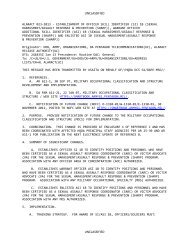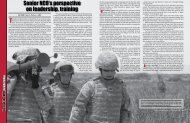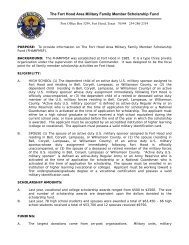Testing in a Joint Environment Roadmap - U.S. Army Operational ...
Testing in a Joint Environment Roadmap - U.S. Army Operational ...
Testing in a Joint Environment Roadmap - U.S. Army Operational ...
You also want an ePaper? Increase the reach of your titles
YUMPU automatically turns print PDFs into web optimized ePapers that Google loves.
For Official Use Only<br />
<strong>Test<strong>in</strong>g</strong> <strong>in</strong> a Jo<strong>in</strong>t <strong>Environment</strong> <strong>Roadmap</strong><br />
Changes to acquisition also seek to reduce acquisition cycle time significantly. Increased<br />
reliance on evolutionary acquisition processes that address capability needs <strong>in</strong> a series of timephased<br />
<strong>in</strong>crements with modular open systems, advanced concept technology demonstrations<br />
(ACTD), and flexible entry <strong>in</strong>to systems acquisition via multiple process paths such as ACTDs<br />
and JFCOM Transformation Change Proposals, are some of these <strong>in</strong>itiatives. The evolv<strong>in</strong>g<br />
acquisition practices impact the way T&E is conducted and must be considered <strong>in</strong> this roadmap.<br />
The test<strong>in</strong>g <strong>in</strong> a jo<strong>in</strong>t environment capability is needed throughout a system's acquisition and<br />
employment lifecycle and will be used to ensure jo<strong>in</strong>t mission capability needs are satisfied to<br />
meet Acquisition Decision criteria. Acquisition programs will be held responsible for meet<strong>in</strong>g<br />
the mission criteria imposed <strong>in</strong> JCIDS documents.<br />
2.2 CHANGES TO T&E METHODS AND PROCESSES<br />
T&E must adapt test methodologies to be prepared to test systems and systems-of-systems <strong>in</strong><br />
assigned jo<strong>in</strong>t mission environments and accommodate evolv<strong>in</strong>g acquisition processes.<br />
However, test<strong>in</strong>g <strong>in</strong> a jo<strong>in</strong>t environment will not require new test milestones, but will be<br />
conducted <strong>in</strong> the context of exist<strong>in</strong>g DT&E and OT&E (<strong>in</strong>clud<strong>in</strong>g IOT&E) events def<strong>in</strong>ed <strong>in</strong><br />
each TEMP. <strong>Test<strong>in</strong>g</strong> <strong>in</strong> the jo<strong>in</strong>t environment will provide the necessary resources and scenarios<br />
to meet the realistic combat conditions necessary for an adequate IOT&E. The def<strong>in</strong>ition of jo<strong>in</strong>t<br />
missions <strong>in</strong> JCIDS documents will simply mean exist<strong>in</strong>g tests will <strong>in</strong>clude the broader context of<br />
the jo<strong>in</strong>t mission environment(s) applicable. The basic requirements for operational test<strong>in</strong>g<br />
established <strong>in</strong> Title 10 USC Section 2399 and support<strong>in</strong>g Department policies will rema<strong>in</strong><br />
unchanged. Additionally, test<strong>in</strong>g <strong>in</strong> a jo<strong>in</strong>t environment will not add a new type of operational<br />
test or test report<strong>in</strong>g requirement. Rather, results will be reported with<strong>in</strong> exist<strong>in</strong>g required test<br />
reports.<br />
2.2.1 FRAMEWORK FOR DEFINITION OF CAPABILITIES<br />
The acquisition and T&E communities need a clear and standardized def<strong>in</strong>ition of the<br />
explicit jo<strong>in</strong>t mission capability needed to guide the design, development, and evaluation of the<br />
materiel solution. There must be enough specificity <strong>in</strong> terms of missions and operational tasks<br />
and measurable performance metrics and conditions (derived from the UJTL) for PMs to<br />
understand the mean<strong>in</strong>g of “jo<strong>in</strong>tness” and know what to build, and for testers to determ<strong>in</strong>e<br />
what/how to test.<br />
The Department still struggles to settle on the specific process and manner for def<strong>in</strong><strong>in</strong>g jo<strong>in</strong>t<br />
warfight<strong>in</strong>g capability gaps and materiel capability needs. The basic assumption <strong>in</strong> new 5000<br />
and 3170 series directives and <strong>in</strong>structions was that operational, systems, and technical <strong>in</strong>tegrated<br />
architectures were the preferred method for describ<strong>in</strong>g <strong>in</strong>teractions and assess<strong>in</strong>g future<br />
capability needs. Yet the <strong>in</strong>tegrated architectures are not prov<strong>in</strong>g adequate for def<strong>in</strong><strong>in</strong>g<br />
capability needs.<br />
7<br />
For Official Use Only






